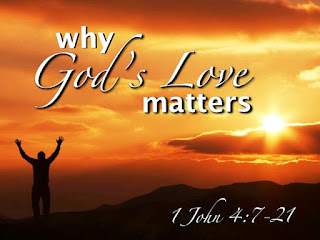Apples, Eggs, Ice Cubes, and God
SUPPORT FROM THE NATURAL:
What do apples, eggs,
ice-cubes, and shamrocks all have in common? Each of them is but only a few of
the many illustrations that have been used to help describe the Triune God of
the Bible.
My personal favorite by the way, is the candle-flame illustration.
The candle-flame illustration goes something like this; you take three candles
and light only one of them with fire. The fire from the lit candle now has its
own individual flame. Next, you take the other two unlit candles, and use the
flame from the lit candle to light the other two wicks. Once you have lit the
last two candles with the fire from the first lit candle, you will come away
with three separate candle-flames, all from the same fire – hence, three
flames, one fire.
Norman Geisler does a
wonderful job using a mathematical illustration in attempting to explain this
phenomenal mystery of our Triune God by saying; “Does not 1 + 1 + 1 = 3? It
certainly does if you add them, but Christians insist that the triunity of God
is more like 1 x 1 x 1 = 1. God is triune, not triplex. His one essence has
multiple centers of personhood. Thus, there is no more mathematical problem in
conceiving the Trinity than there is in understanding 1 cubed (13)” (Geisler, p.732).
St. Augustine sought to
explain this great mystery by using a moral illustration to describe God’s
triune nature. He said that “God . . . had left triune footprints everywhere in
the created order” (Oden, Thomas C. Systematic Theology: Volume One. p.185), including in the very act of love itself.
Augustine believed that “love requires a lover, one who is loved, and the love
that unites them, in a kind of three-in-oneness, for in speaking of these
three, we are speaking only of one thing, love” (Oden, p.186). Oden argues that
these “are the conceptual requisites of tri-unity: all have unity, equality,
and distinguishability” (ibid).
With all of the many
feeble illustrations that we as humans attempt to conjure up in order to
explain the triune nature of God, it is no wonder that the concept of the
Trinity still remains as one of the greatest mysteries of the Christian faith.
When speaking about the Trinity it should be pointed out that it is a word that
is never mentioned in the Bible, (Neither is Eschatology, Soteriology,
Pneumatology, or many other “ologies” used, but they are still accepted
doctrines throughout the Christian and Non-Christian world) yet the concept of Trinity is plainly taught throughout the Scripture.
SUPPORT FROM THE BIBLE:
There are two biblical
truths that support the teaching of the Trinity. The first truth is the central
theme of Judaism, which is called the Shema. The Shema comes from Deuteronomy
6:4, and states: “Hear O, Israel: The LORD our God, the LORD is one!” which was
echoed by Jesus as the first of all commandments (Mk. 12:29). David proclaimed,
“You alone are God” (Ps. 86:10). The Lord speaks through His prophet Isaiah by
telling us, “That you may know and believe Me, and understand that I am He.
Before Me there was no God formed, nor shall there be after Me. I, even I, am
the Lord, and besides Me, there is no Savior” (Isa. 43:10-11). When looking at
the Word of God, it is overwhelmingly clear that God is one (cf. Jn. 17:3; 1
Tim. 2:5).
The second truth is that
the Bible clearly teaches us there are three distinct persons revealed in
Scripture as God. The Bible tells us that there is God the Father, God the Son,
and God the Holy Spirit. Isaiah the prophet reveals the triune nature of God by
identifying the One true God as a “Son” who is given (Son of God), “Wonderful
Counselor” (a possible allusion to the Holy Spirit – cf. Jn. 15:26), and
“Mighty God,” who is the “Everlasting Father” (Isa. 9:6). In this passage from
Isaiah it is very clear that Jesus is that Child, and Son that was given, as well
as the Wonderful Counselor, and Everlasting Father, who is known as the One
true “Mighty God.” We have three persons, yet One God.
Norman Geisler says; “By
saying God has one essence and three persons it is meant that he has one “What”
and three “Who’s.” The three Who’s (persons) each share the same What
(essence). So God is a unity of essence with a plurality of persons. Each
person is different, yet they share a common nature” (Geisler, p.732).
THE OLD TESTAMENT:
This idea of a Triune God
is witnessed from the very beginning of Scripture. Though Judaism’s central
claim about Yahweh is the fact that He alone is the “One” true God, and there
is no other God but Him (cf. Deut. 6:4), it cannot be ignored that God in many
places throughout the Old Testament revealed His Triune nature to them. In fact
in the very first verse of the Bible, and the very first mention of God, we
read: “In the beginning God” (Gen. 1:1). Jon Courson tells us that; “The Hebrew
word translated ‘God’ is Elohim, [is a] compound unity. El is singular. Elo is
used for two. Elohim refers to three or more. “Hear, O Israel, the Lord your
God, Elohim, is one compound unity.” Listen carefully to the Shema, and you’ll
hear the Trinity” (Courson, p.555)
GENESIS 1:26
We see glimpses of God’s
triunity in Genesis 1:26, when He says, “Let Us make man in Our image,
according to Our likeness” (cf. Gen. 11:7). Looking at Isaiah 48:16, we see what
I believe to be one of the most convincing passages in all of Scripture that
supports the concept of the Trinity. Isaiah 48:16 says, “Come near to Me, hear
this: I have not spoken in secret from the beginning; From the time that it
was, I was there. And now the Lord GOD and His Spirit have sent Me.” Oden states; “Isaiah
48:16 is a principal prophetic text from which classical exegetes have argued an
implicit triune intimation. The speaker is the Lord’s Servant, the promised
Messiah . . . The first person Me has been widely thought by classical exegetes
to be anticipatory of the Son (viewed by analogy of faith from the New
Testament), who speaks of the Lord God by whom he is sent and the Spirit with
whom he is sent, thus keeping all the primary elements of triunity in place:
unity, distinction, and complementary mission” (Oden, p.190).
It is quite clear that God
revealed Himself to the Israelites as a triune God, but due to their spiritual
blindness, they were not able to fully comprehend the greatness of God.
THE NEW TESTAMENT:
When looking through the
New Testament we see the Trinitarian idea even more clearly revealed.
THE BAPTISM OF JESUS:
At the Baptism of Jesus,
we witness the Trinity. While Jesus is being baptized (Mt. 3:16), the Holy
Spirit is descending in bodily form (Lk. 3:22), and at the same time we hear
God the Father speak about how pleased He is with Jesus (Mt. 3:17). We have One
God appearing in three distinct Persons. We can witness the Trinity in the
Great Commission’s Baptismal instructions (Mt. 28:19). We see this triune
teaching in Paul’s writings (Col. 2:9; 1 Tim. 3:16; 2 Cor. 13:14; Rom. 8:9-11).
DIVINE ATTRIBUTES OF GOD:
We can also see the
Trinity throughout the Bible by the Divine attributes and acts that take place.
For example, the Bible tells us that God the Father made us (Isa. 44:24), Jesus
made us (Jn. 1:3; Col 1:16), and the Spirit made us (Job 33:4), while at the
same time we read that God made us alone by Himself (Isa. 44:24). One God -
three distinct persons – all taking part in our creation. The Bible describes
God the Father as the “Almighty” (Gen. 35:11), Jesus as the “Almighty” (Rev.
1:8), and the Spirit as the “Almighty” (Job 33:4). One God - three distinct persons
who are “Almighty.”
THE RESURRECTION:
The Bible tells us that
God the Father would raise Jesus from the dead (Acts 3:15), the Holy Spirit
would raise Jesus from the dead (Rom. 8:11) and that Jesus would raise Himself
from the dead (Jn. 2:19). One God - three distinct persons – all taking part in
raising Jesus from the dead.
SALVATION:
The Bible also tells us
that no one can come to Jesus unless the Father draws them (Jn. 6:44), the
Spirit draws them (Jn. 3:8), or the Son drawing them (Jn. 12:32; Lk. 10:22).
One God - three distinct persons – all taking part in drawing us to Jesus for
salvation.
As we have seen, God
appears in the New Testament as Father, Son, and Spirit, and there is no
sweeter picture of the Triune God throughout the Bible, than in His act on our
behalf to secure our Salvation. He is God the Father who drew us to Christ (Jn.
6:44), God the Son who paid for our sins (Rom. 5:8-9), and God the Spirit who
dwells within us, and helps us (Jn. 14:16-17), and has sealed us for the day of
redemption (Eph. 1:13, 4:30).
CONCLUSION:
“Augustine concluded that
the reason we talk about trinity at all is not because we can say something
adequately about it, but rather because, in the absence of adequate speech, we
must say something” (Oden, p.224).
We should find great
comfort in knowing that our God is not an apple, egg, ice-cube, or shamrock,
but the One True God, who has revealed Himself to us as a Loving Father, a
Sacrificial Son, and a Comforting Spirit.
Amen.
____________
* Bibliography
Oden, Thomas C. Systematic
Theology: Volume One. Hendrickson
Peabody, MA: Hendrickson. 1999
Geisler, Norman L. Baker
Encyclopedia of Christian Apologetics, Baker Books, Grand Rapids, MI. 1999.
Courson, Jon. Application
Commentary: Old Testament, Thomas
Nelson, Nashville, TN, 2005



